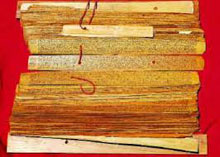The Sangam Age constitutes an important chapter in the history of South India. According to Tamil legends, there existed three Sangams (Academy of Tamil poets) in ancient Tamil Nadu popularly called Muchchangam. These Sangams flourished under the royal patronage of the Pandyas. The first Sangam, held at Then Madurai, was attended by gods and legendary sages but no literary work of this Sangam was available. The second Sangam was held at Kapadapuram but the all the literary works had perished except Tolkappiyam. The third Sangam at Madurai was founded by Mudathirumaran. It was attended by a large number of poets who produced voluminous literature but only a few had survived. These Tamil literary works remain useful sources to reconstruct the history of the Sangam Age.
Sangam Literature
 |
| Sangam Literature |
The corpus of Sangam literature includes Tolkappiyam, Ettutogai, Pattuppattu, Pathinenkilkanakku, and the two epics – Silappathigaram and Manimegalai. Tolkappiyam authored by Tolkappiyar is the earliest of the Tamil literature. It is a work on Tamil grammar but it provides information on the political and socio- economic conditions of the Sangam period. The Ettutogai or Eight Anthologies consist of eight works – Aingurunooru, Narrinai, Aganaooru, Purananooru, Kuruntogai, Kalittogai, Paripadal and Padirruppattu. The Pattuppattu or Ten Idylls consist of ten works – Thirumurugarruppadai, Porunararruppadai, Sirupanarruppadai, Perumpanarruppadai, Mullaippattu, Nedunalvadai, Maduraikkanji, Kurinjippatttu, Pattinappalai and Malaipadukadam. Both Ettutogai and Pattuppattu were divided into two main groups – Aham (love) and Puram (valour). Pathinenkilkanakku contains eighteen works mostly dealing with ethics and morals. The most important among them is Tirukkural authored by Thiruvalluvar. Silappathigaram written by Elango Adigal and Manimegalai by Sittalai Sattanar also provides valuable information on the Sangam polity and society.
Other Sources
In addition to the Sangam literature, the Greek authors like Megasthenes, Strabo, Pliny and Ptolemy mention the commercial contacts between the West and South India. The Asokan inscriptions mention the Chera, Chola and Pandya rulers on the south of the Mauryan empire. The Hathikumbha inscription of Kharavela of Kalinga also mentions about Tamil kingdoms. The excavations at Arikkamedu, Poompuhar, Kodumanal and other places reveal the overseas commercial activities of the Tamils.
